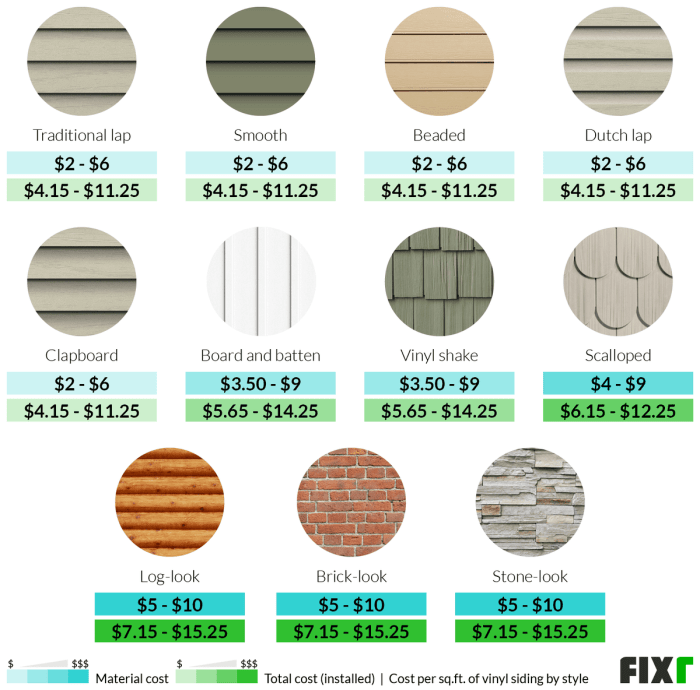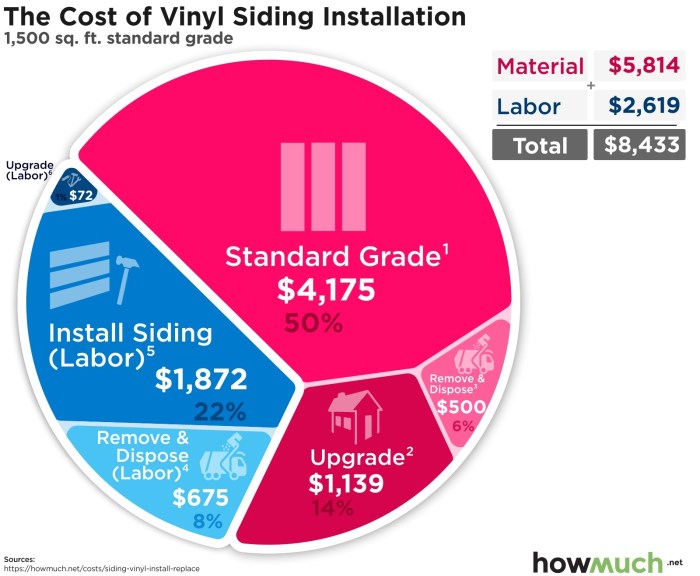Exploring the Average Price of Vinyl Siding
The average price of vinyl siding sets the stage for this enthralling narrative, offering readers a glimpse into a story that is rich in detail and brimming with originality from the outset. As we delve into the factors that influence pricing, compare vinyl siding prices with other types of siding, and explore different grades, thicknesses, and installation costs, a comprehensive understanding of this topic awaits.
Factors influencing the average price of vinyl siding

When considering the average price of vinyl siding, several factors come into play that can impact the overall cost. Understanding these factors is essential for homeowners looking to invest in this type of exterior cladding.
Material Quality Impact
The quality of the vinyl siding material itself plays a significant role in determining the price. Higher-quality vinyl siding, often with better durability and aesthetic appeal, will come at a higher cost compared to lower-quality options. The thickness, texture, and color options can all contribute to the pricing of vinyl siding.
Installation Complexity
The complexity of the installation process can also affect the overall price of vinyl siding. Factors such as the size and shape of the home, the need for additional preparation work, and the presence of architectural details can increase the labor costs involved in the installation.
More complex installations may require more time and expertise, leading to higher overall costs.
Regional Variations
Regional variations in pricing can also impact the average cost of vinyl siding. Factors such as local labor rates, competition among contractors, and the cost of living in different areas can all influence the final price. Homeowners should consider these regional variations when budgeting for vinyl siding installation.
Additional Features like Insulation
The inclusion of additional features like insulation can add to the overall price of vinyl siding. While insulation can increase energy efficiency and improve the comfort of the home, it comes at an additional cost. Homeowners should weigh the benefits of these features against the added expense when deciding on the right vinyl siding for their needs.
Comparison of vinyl siding prices with other types of siding
When considering siding options for your home, it's important to compare the average prices of vinyl siding with other types of siding materials to make an informed decision.
Wood Siding
Wood siding is a popular choice for its natural beauty, but it comes with a higher price tag compared to vinyl siding. On average, wood siding can cost between $6 to $10 per square foot, making it more expensive than vinyl siding.
Metal Siding
Metal siding is known for its durability and low maintenance, but it is generally more costly than vinyl siding. The average cost of metal siding ranges from $7 to $12 per square foot, depending on the type of metal used.
Fiber Cement Siding
Fiber cement siding is a versatile and durable option that falls in the mid-range pricing category. It typically costs between $5 to $9 per square foot, making it slightly more expensive than vinyl siding.
Engineered Wood Siding
Engineered wood siding is a cost-effective alternative to traditional wood siding, and it is comparable in price to vinyl siding. The average cost of engineered wood siding ranges from $4 to $8 per square foot, making it a budget-friendly option for homeowners.
Average prices for different grades or thicknesses of vinyl siding
When it comes to vinyl siding, the cost can vary based on the grade or thickness of the material. Understanding the differences in pricing between standard, mid-range, and premium vinyl siding grades can help homeowners make informed decisions.
Breakdown of Vinyl Siding Grades
- Standard Grade: Typically the most affordable option, standard vinyl siding is thinner and may have fewer design options. Prices for standard grade vinyl siding can range from $2 to $4 per square foot.
- Mid-Range Grade: Offering more durability and design choices than standard grade, mid-range vinyl siding falls in the middle in terms of pricing. Homeowners can expect to pay between $4 to $6 per square foot for mid-range vinyl siding.
- Premium Grade: Known for its exceptional durability, premium vinyl siding is thicker, more impact-resistant, and offers a wide range of colors and styles. Prices for premium grade vinyl siding can start from $6 per square foot and go up to $10 or more.
Impact of Thickness on Pricing
The thickness of vinyl siding directly affects its pricing. Thicker siding is often associated with higher quality and durability, which can justify the higher cost. Thicker vinyl siding may also offer better insulation properties, potentially leading to energy savings in the long run.
Durability and Longevity in Relation to Cost
Higher grades of vinyl siding, which are thicker and more durable, tend to come with a higher price tag. However, the increased cost is often justified by the longevity and low maintenance requirements of premium vinyl siding
Examples of Price Ranges
| Grade | Price Range per Square Foot |
|---|---|
| Standard | $2
|
| Mid-Range | $4
|
| Premium | $6+ |
Understanding the installation costs and factors affecting them

When it comes to installing vinyl siding, there are several factors that can affect the overall cost. Let's delve into the typical installation expenses associated with vinyl siding and how various factors come into play.
Size of the project
The size of the project plays a significant role in determining installation costs. Larger projects with more surface area to cover will naturally require more materials and labor, resulting in higher costs.
Additional factors impacting installation pricing
Aside from project size, other factors such as labor rates and permits can also impact installation pricing. Labor rates vary depending on location and the complexity of the project, while permits may be required in some areas, adding to the overall cost.
DIY installation vs. hiring professionals
While some homeowners may opt for a do-it-yourself approach to save on installation costs, it's essential to consider the potential pitfalls of DIY installation. Hiring professionals ensures proper installation, potentially saving money in the long run by avoiding costly mistakes that may arise from DIY attempts.
Tips for saving money on vinyl siding projects
When planning a vinyl siding project, there are several ways to save money without compromising on quality. From finding cost-effective options to negotiating with contractors, these tips can help you stay within budget and get the best value for your investment.
Finding Cost-Effective Vinyl Siding Options
When looking for cost-effective vinyl siding options, consider shopping around and comparing prices from different suppliers. Look for sales, promotions, or discounts to get a better deal. You can also consider purchasing siding in bulk or opting for off-season purchases when prices are typically lower.
Reducing Labor Costs During Installation
To reduce labor costs during the installation process, you can consider doing some of the prep work yourself, such as removing old siding or cleaning the work area. This can help save time and money on labor charges. Additionally, try to schedule the installation during the contractor's off-peak season when rates may be more competitive.
Negotiating Pricing with Contractors
When negotiating pricing with contractors for vinyl siding projects, be upfront about your budget and ask for itemized quotes to understand where the costs are coming from. Compare quotes from multiple contractors and don't hesitate to negotiate for a better price or ask for discounts.
Consider bundling multiple services or projects to get a better deal.
Long-Term Cost Benefits of Quality Vinyl Siding
While investing in quality vinyl siding upfront may come with a higher initial cost, it can offer long-term cost benefits. High-quality siding is more durable, requires less maintenance, and can improve energy efficiency, leading to potential savings on heating and cooling costs over time.
Consider the long-term value when making your decision.
Ending Remarks
In conclusion, the discussion on the average price of vinyl siding has shed light on the complexities of pricing, installation costs, and ways to save money on projects. Whether you're considering vinyl siding for your home or simply curious about the costs involved, this exploration has provided valuable insights to guide your decision-making process.
Key Questions Answered
What role does material quality play in determining the average price of vinyl siding?
Material quality significantly impacts pricing as higher-quality vinyl siding tends to be more durable and aesthetically pleasing, leading to a higher cost.
How does the size of a project affect installation costs for vinyl siding?
The size of the project directly influences installation costs, with larger projects typically requiring more materials and labor, resulting in higher overall expenses.
Where can one find cost-effective vinyl siding options to save money?
Cost-effective vinyl siding options can often be found at local home improvement stores, during seasonal sales, or by exploring online suppliers for discounts.
Is DIY installation of vinyl siding more cost-effective than hiring professionals?
While DIY installation may save money upfront, hiring professionals ensures proper installation and can prevent costly mistakes in the long run.
What long-term cost benefits come with investing in quality vinyl siding upfront?
Investing in quality vinyl siding upfront can lead to lower maintenance costs, improved energy efficiency, and increased property value over time.